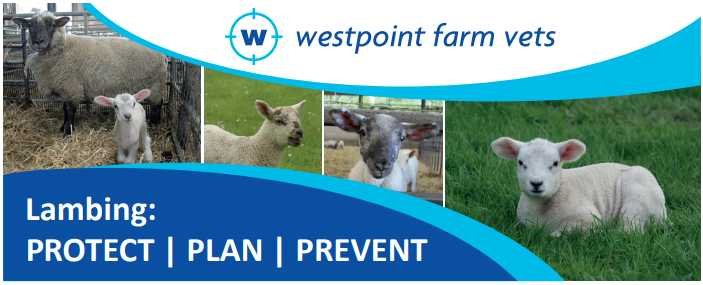Lambing: PROTECT | PLAN | PREVENT
Lambing advise from Westpoint Farm Vets
Getting the lambing facilities ready
- Good hygiene of the lambing environment for both indoor and outdoor systems – with appropriate stocking densities and lie-back areas and lambing pens that are dry, draft-free and cleanly bedded with appropriate cleansing and disinfection between occupants.
- When lambing assistance is required, clean gloves should be used for all ewes and hands regularly washed. Navels should be fully immersed in a 10% iodine solution as promptly as possible after birth.
- Maximum hygiene during husbandry procedures such as stomach tubing, ear tagging and castration or tailing (only undertake where necessary) & suitable cleansing and disinfection of equipment between individual animals.
Key Rules for colostrum feeding: Quality, Quantity, Quickly
- All lambs should receive 50ml/kg of colostrum in the first 2 hours following birth and a total of 200-250 ml/ kg before end of 24 hours, so a 4kg lamb at birth needs 800ml of colostrum to give it essential levels of natural immunity.
- If not adequate supply, quality or quantity - substitute with other ewes colostrum, goat1 or cow2 colostrum or commercial substitutes3 . Save good colostrum in zip lock bags for easy defrosting.
- Gently defrost for use (don’t zap it in a microwave as this will damage the IgG). If too hot for your hand then too hot for colostrum. It should be heated to 39°C
Suggestions for use of oral antibiotics in prevention of watery mouth
- Good practice: providing lambs adequate colostrum, quickly enough, will enable them to cope with a few bugs without need for antibiotic treatments and establish a healthy population. Colostrum-deprived lamb is not able to control the multiplication of E.coli.
- Target treatments:
- Identify low and high risk lambs in order to target treatments
- Try to step away from blanket treatment of all lambs at birth as it is not appropriate for all lambs to be treated routinely from the start of a new lambing season.
- Lower risk lambs: have received adequate colostrum, are fit and healthy single lambs, born in the first week of lambing into clean, dry and well-sheltered environment
- Antibiotics against watery mouth should be reserved for priority cases, targeted towards high risk lambs: triplet or low birth weight lambs that are born later on in lambing period with more challenging environmental conditions into group with recent clinical cases; lambs born to thin and/or poorly fed ewes.
- Start with small changes: first try to keep 10% or more without treatment; then, from there on, assess, monitor and allow for changes to plan.
Ask your vet for guidance for your flock
1 is safer than from cows; should come from CAE-accredited herds
2 should be pooled and as it is not as concentrated, then 30% more needed to make up the energy; should come from a Johne’s free herd
3 are expensive and often relatively poor in both energy and antibody content

- 1st February 2021
